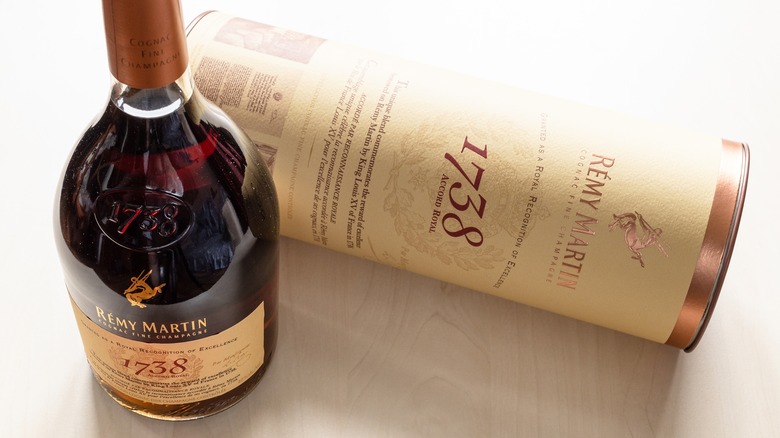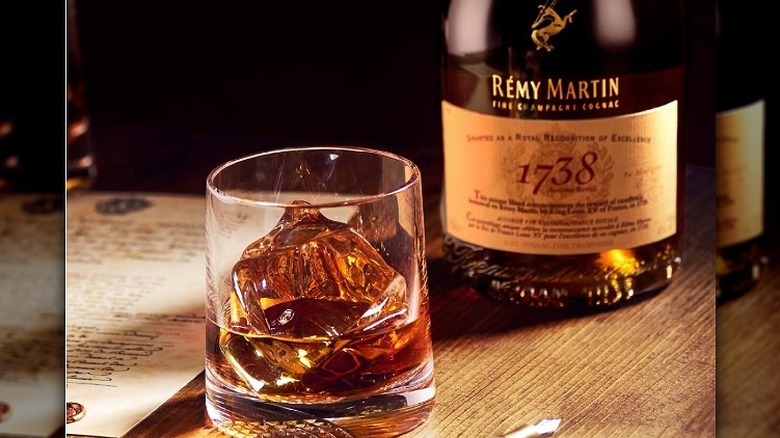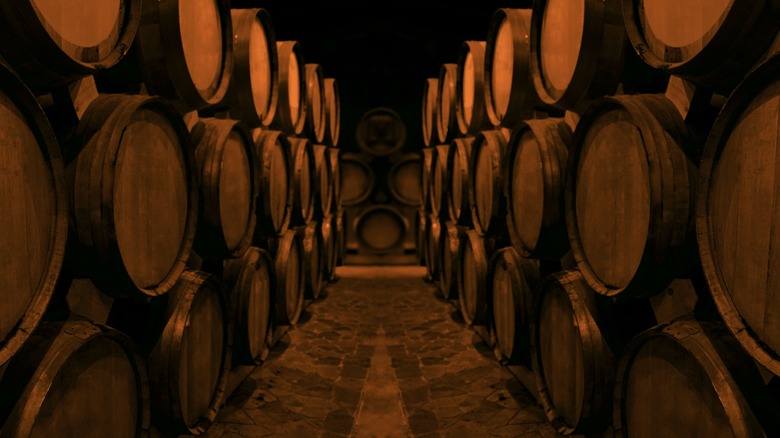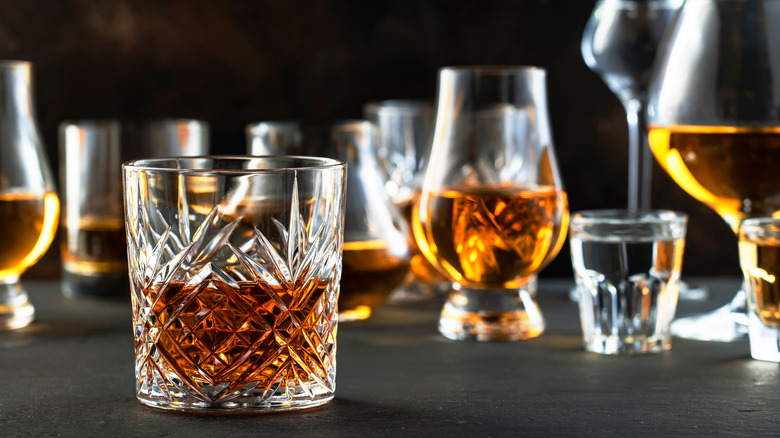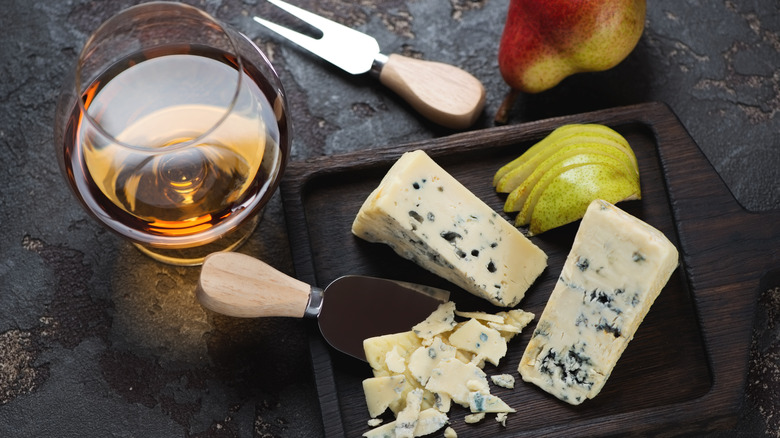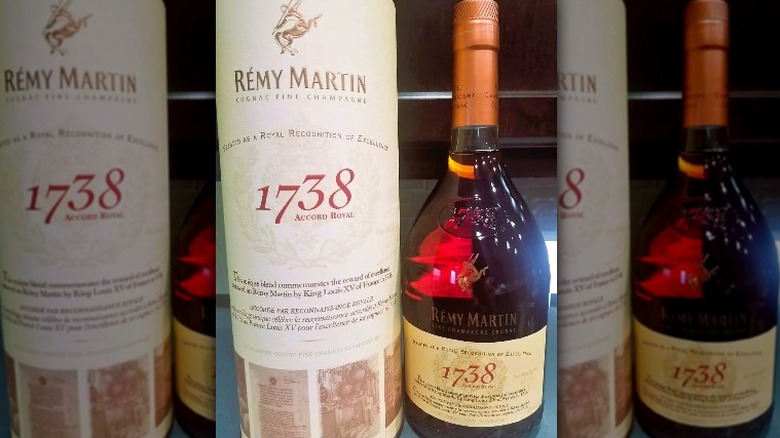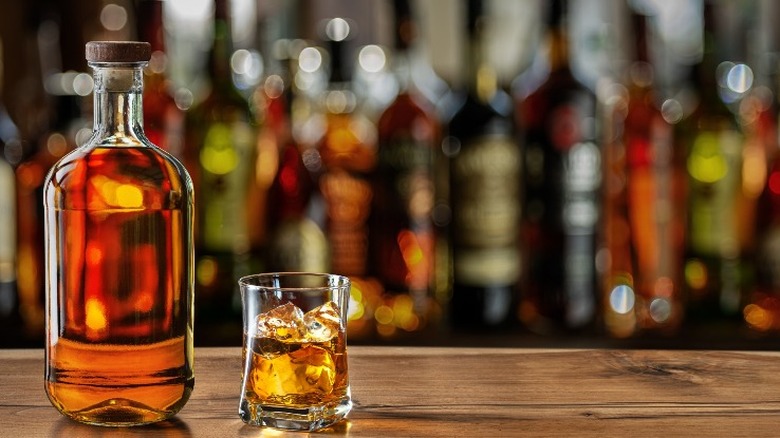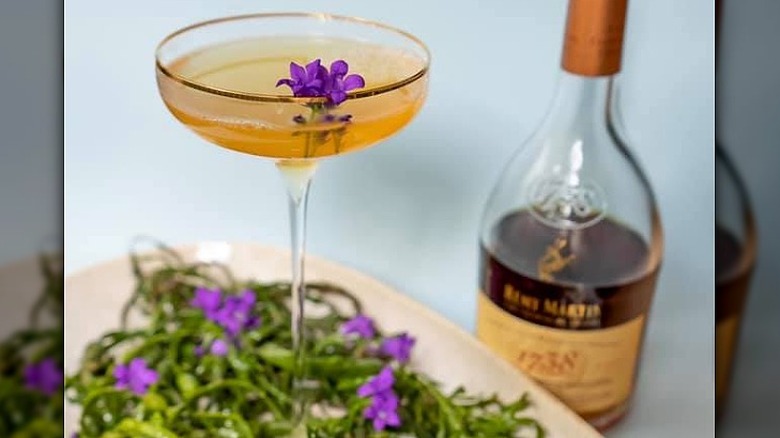Remy Martin 1738 Accord Royal: The Ultimate Bottle Guide
Just north of France's Bordeaux region is Cognac, a small but highly respected wine region that produces premium wine-based distilled Eaux-de-vie brandy that accounts for a $77 billion industry globally in 2020, of which $12 billion comes from the United States (via Statista).
One of the region's leading producers is Rémy Martin, which began in 1724. In the first quarter of 2022, Rémy Cointreau, the parent company of Rémy Martin, enjoyed +27% organic growth over the previous year's sales, notes Business Wire. It adds that the Cognac division of the company has seen a +30% organic growth year over year, with one of the top products helping this growth in the United States being Rémy Martin 1738 Accord Royal Cognac.
Creamy and rich, with a full-flavored palate that would make you believe you are drinking a much older and more expensive brandy than you are, Liquor.com feels Rémy Martin delivers quality with affordability in its 1738 Accord Royal Cognac.
The brand has created a following with rap stars, musicians, athletes, and celebrities. Vinepair shares the 80-proof copper-colored elixir is a favorite of musician Drake, Usher has a bottle of his own, Fetty Wap has an entire society named after the brand, and actor Jeremy Renner talks of hoisting glasses of Rémy Martin on CNN.
So what about Rémy Martin's 1738 Accord Royal Cognac is so special? Let's dig into everything you have ever wanted to know about this notable brand and the bottle.
Rémy Martin earned the Accord Royal in 1738
Cognac is a wine-based liquor that goes through a double distillation process in small, copper pot stills with a history dating back to the 1600s (via Liquor.com). This double-distillation is the main difference between Cognac and Armagnac, as the other French brandy distills only once.
In 1724, a wine grower named Rémy Martin began producing Cognac within Charente in the heart of the Cognac region. The first bottles were released a decade later and labeled under his name, reports Kuletos. The brandy quickly gained recognition for its quality, specifically with the King of France.
At the time, the land was owned by the crown, and it was illegal for wine growers to plant new vines to expand a winery's production without the King's permission. In 1738, King Louis XV granted the producer an accord royal (or royal decree), allowing for the rare privilege to expand the vineyard due to his enjoyment and appreciation of the young wine grower's brandy, the cocktail bar adds.
Difford's Guide shares that fruit from those vines found its way into Rémy Martin's Cognac production 14 years later. In 1997, La Maison Rémy Martin's third cellar master for the producer, Georges Clot, blended the first bottles of the 1738 Accord Royal Cognac. Blending various age styles in one bottle and labeling it without an age designation, the Cognac became a tribute to the prestigious decree the House received so many years before.
How does Rémy Martin 1738 Accord Royal taste?
Eau de vie may mean "water of life," but it must blend with other Eau de vies to become great Cognac (via Liquor.com). The mix of Eau de vies from various regional producers will give depth and richness to the resulting Cognac.
Rémy Martin works with over 1,000 winegrowers who submit their eau de vie for sampling and selection to the tasting committee. Cellar master, Baptiste Loiseau, told us in a 2014 interview on how to drink Cognac that the tasting committee evaluates 25-35 samples in a row, all by smell. The aroma will define the aging potential of the 140,000 Eaux de vie the House is aging in its 29 cellars.
To produce the Accord Royal, youthful, four-year oak-aged Cognac blends with 20-year oak-aged Cognac creating a range of flavors and textures. Liquor.com reports that the young V.S.O.P. delivers fruity flavors but with concentration often found in older styles. In contrast, the older X.O. brings spice and dried fruit without the heavily aged woody notes often associated with well-aged liquors. Balanced and refined, the two styles meld to create smooth, creamy, unctuous harmony.
We tried the Cognac and found aromas of fresh plums and citrus melding with toasted nutmeg and allspice. Fruity flavors are present throughout the palate, melding with butterscotch, toffee, and spiced nuts. The finish is slightly bitter, showing dark chocolate and cedar, enhanced by the oak aging without overpowering the overall taste.
240 eaux de vie produce of Rémy Martin 1738 Accord Royal
The start of all Cognac is wine. Tart, high acid Ugni Blanc is the primary grape used for producing Cognac (via Wine Folly). The wine goes through alcoholic and malolactic fermentation, transforming the tart acidity into a smooth, creamy wine which is then distilled to produce the fruit-based eau de vie brandy.
Cognac shares 240 Eaux de vie brandies go into the production of the Accord Royal. This Eaux de vie is from fruit grown exclusively in Grande Champagne and Petite Champagne, making it a Fine Champagne Cognac. With a focus on sustainability, the House achieved High Environmental Value certification in 2012, with all growers and producers for Remy Martin working sustainability with respect for the environment.
The Accord Royal is a unique brandy in that so many Eaux de vie are used in the production and how it is aged. 1738 includes brandy aged as little as four and as old as 20, with an average age of 12 (via Difford's Guide).
All Eaux de vie ages in new and neutral French oak barrels, per the Cognac production regulations. The oak gives the alcohol the color and flavor, which Wine Folly explains will give rich oak influence on the alcohol the longer it remains in oak. All Rémy Martin barrels are produced from more than 100-year-old Limousin oak trees, with an open grain giving notes of vanilla and chocolate, along with nuttiness and toasted oak.
The best way to drink Rémy Martin 1738 Royal Accord is with this glass
The shape of your cocktail glass is so important, like which to use when sipping an aromatic Cognac. Over the years, the classic snifter glass, with its large globe shape, has been the go-to for sipping Cognac. Vinepair shares the balloon-shaped glass with a round body, and the narrow opening accentuates the brandy's delicate aromas.
However, not all believe the traditional vessel is best. Maximilian Riedel, president of Riedel Crystal, told Wine Enthusiast the snifter glass is the worst you can use for Cognac or any beverage. The design of the glass, with a broad base and narrow top, enhances the aromas. Still, it also concentrates the intensity of the liquor, giving your nose the hot burn of alcohol when inhaling the scent. Instead of picking up the elegant essence of the spirit, the aromas will disappear as your sense of smell will be crushed.
The premier glass maker suggests using a tulip-shaped tasting glass, often used for sipping whiskey neat. A round body and a slight lip on the rim allow appreciation of the brandy's fresh fruitiness without the burn. The wine site adds that if a tulip glass isn't handy, a short liqueur or port glass is a great substitute, giving the same effect. If you prefer your Cognac with a few ice cubes, Insider suggests a classic tumbler, or rocks glass, which will work fine.
Enjoy the Cognac neat, in cocktails, or with food
You may have memories of your parents or grandparents sipping Cognac from goblets at the end of a meal. Fast-forward to today, and Cognac is being enjoyed in cocktails as aperitifs, paired with dishes throughout dinner, and enjoyed neat at the end of a night.
Since the Accord Royal contains youthful and well-aged Cognac, it works well in modern and classic cocktails. As the toasted hazelnut, sweet spice, and dried fruit flavors are similar to those you would find in an aged whiskey, we love 1738 in a smooth old fashioned, Manhattan, or stir it into the original sidecar. Rémy Martin cellar master Baptiste Loiseau suggests mixing it with ginger ale, accentuating the spiciness and floral notes.
For food pairings, Cognac shares that umami is the spirit's best friend, so dishes filled with the fifth taste will pair well with the brandy. The consortium adds that young Cognac will pair nicely with fresher flavors, like fresh fruits, soft cheese, and fish, whereas older Cognac should meld with bolder, spiced flavors. As the Accord Royal average age is 12 years, dishes like roasted game birds will work, as will a pâté of foie gras, Roquefort cheese, mushroom dishes, and baked tarts, like our sweet and savory apple and cheddar tarte tatin.
If you prefer to sip your Cognac neat, you would be in good company with Baptiste Loiseau. He believes consuming it straight allows full appreciation of the intoxicating aromas.
Rémy Martin 1738 Accord Royal delivers value with great taste
Cognac is categorized based on the minimum time the eau de vie is aged in French oak casks. The Cognac Expert defines each official style noting the youngest is V.S., or very special, with an aging minimum of at least two years. Next is V.S.O.P., or very superior old pale, a Cognac aged a minimum of four years in oak. Next is X.O. Cognac, or extra old, with a 10-year age minimum. All Cognac of every style and region ages the same way.
Though Rémy Martin does not designate an age for the Accord Royal, choosing to pay homage to the King's grant instead, Cognac Expert includes it in the unofficial style of a Napoleon Cognac with a six-year minimum age, as much of the brandy is over 20 years old. Though you can't compare the two exactly, Courvoisier makes one of the most well-known Napoleon Fine Champagne Cognacs, but with a higher price tag (via Wine-Searcher).
Wine-Searcher adds a typical bottle of X.O. Cognac or Cognac aged at least 10 years, like Rémy Martin X.O. Excellence, averages $206, compared to the Accord Royal's average price is $66. Liquor.com adds its concentrated fruitiness and creamy, generous palate, along with the affordable price, making the libation a perfect base for cocktails, like the original mint julep. And Rémy Martin agrees, noting the Accord Royal will enhance the richness of the American classic.
Rémy Martin 1738 Accord Royal compared to Hennessy V.S.O.P. Privilege
The world's most popular Cognac is Hennessey (via Statista). A giant in the industry, Hennessey sat at No. 86 on the Forbes 200 most valuable brands in 2020.
Though the brand has immense popularity, you shouldn't count Rémy Martin out thanks to the variety of styles the brand continues to craft, like 1738. Cognac enthusiast Jeremy Fowler tells Vinepair that Rémy Martin's continued growth can be attributed to the historic house's innovation with new Cognac interpretations.
Though no other Cognac producer crafts a product exactly like the 1738 Accord Royal, Hennessy's V.S.O.P. Privilege is around the same price point, containing a blend of 60 Eaux de vie and aged four years to 15 years (via Drink Spirits).
When comparing the flavor of the two, Liquor.com says the Accord Royal is fresh and fragrant with concentrated layers of dried fruit, oak, and vanilla. The Cognac has elegance and refinement, with inviting complexity and a woody bitterness that keeps it interesting. Their analysis of the Hennessy V.S.O.P. Privilege highlights an orchard fruit, sweet spice, and oaky intensity in the Cognac, with a cloying, unexpected sweetness. Though it is a quality, well-made product that accurately represents the style, they believe you are paying more for the name than the actual liquor, adding you can find comparable products for a better price point. We agree, enjoying the multiple layers and dimensions of Remy Martin's selection.
Rémy Martin's Champagne has nothing to do with bubbles
Rémy Martin only uses Cognac Fine Champagne fruit grown in Grande Champagne and Petite Champagne within Cognac, not France's celebrated sparkling wine region.
Cognac.com defines the French term "Champagne" as referring to chalk soils found. Champagne's sparkling wine region and Cognac's Champagne regions contain these soils. The two areas at the heart of the Cognac, Grande Champagne, and Petite Champagne, are considered the most premium areas for growing grapes thanks to these soils, creating Cognac Fine Champagne. Because of its quality, the region became an officially recognized "appellation d'origine contrôlée" or A.O.C. in 1938. Wine Folly adds that these Cognac soils produce highly aromatic fruit with floral notes that, through extensive oak aging, create a delicate, refined expression of the fruit.
Cognac from Grande Champagne takes the longest time in barrel to reach its full potential, producing light, delicate flavors, explains Distiller. Grande Champagne Cognac is the most highly regarded product in the region, followed by Petite Champagne.
In 1948, La Maison Rémy Martin became a producer of exclusively Cognac Fine Champagne, believing these soils are the best to ripen the fruit to perfection. They are among the few significant producers to source fruit solely from this area. Rémy Martin's Fine Champagne Cognac for the Accord Royal includes a blend of 65% Grande Champagne and 35% Petite Champagne, (via Cognac.com).
Fetty Wap loves Rémy Martin 1738 Accord Royal
Cognac's tie with African American culture spans decades, with Cognac becoming a favorite with rap stars, musicians, and athletes. Slate reports this liking dates back to the first and second World Wars when African Americans soldiers began sipping the brandy in French cafes while stationed in Cognac fighting for the allies. Through the 1920s and 1930s, Black American musicians embraced the liquor while becoming permanent fixtures in jazz clubs throughout Paris.
They found an appreciation for a spirit and people that celebrated their culture, unlike at home in America, where whiskey brands often focused on Southern nationalism, with brands named after Confederate leaders, Slate adds.
One of Rémy Martin's most prominent present-day fans is New Jersey rapper Fetty Wap, a 1738 lover who believes it is the best liquor in the world. He loves it so much that his loyal entourage is affectionately known as the "Rémy Boyz." The rapper told Rolling Stone that the pack drinks up to 20 bottles of the Accord Royal a night. Wap's hit "Trap Queen," which hit the No. 2 slot on Billboard's Hot 100 in 2015, includes a nod to the Cognac and his beloved gang of brothers in the opening lyrics.
Rémy Martin 1738 Accord Royal was late to reach Europe
Though Cognac is one of the world's most historic beverages, not much is consumed by the country that produces the brandy with less than 5% of Cognac staying within France. Yahoo Finance reports that in 2021, 95% of Cognac was exported out of the country, with China and the United States importing the most significant quantities.
Not much has changed throughout the past 400 years, either. Five years ago, Vinepair shared that international trade was the priority for Cognac producers for centuries, with Cognac being the favorite drink of the Pacific, enjoyed throughout Asia. They add the focus has always been on the export market as French people historically did not have a taste for the liquor, opting to drink whiskey instead.
Because of this, it was almost 20 years after its first release that Europeans could finally enjoy the brand. Cognac Expert shares that the launch came after the product enjoyed success across the pond in America, with bottles finally arriving on European shelves in 2015.
